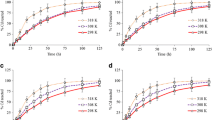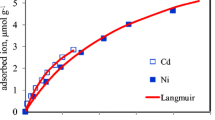Abstract
Two alkaline soils collected from the surface horizon (0–15 cm) of two agricultural fields Lakshmikantapur (LKP; 22° 06′ 03″ N and 88° 18′ 19″ E) and Diamond Harbour (DHB; 22° 11′ N and 88° 14′ E) of West Bengal, India were studied to observe the stability of cadmium (Cd) chelate complexes with diethylenetriaminepentaacetatic acid (DTPA) and ethylenediaminetetraacetic acid (EDTA), removing organic matter (OM). The objective of the present study is “determination of the stability constants and the thermodynamic parameters of Cd-DTPA and Cd-EDTA complexes at different pH and temperatures at the soil-water interface”. Complex formation of soil Cd with DTPA and EDTA at the soil-water interface was studied under different ligand-to-metal ratios, pHs and temperatures. Apparent conditional stability constants (log k´) were calculated from the concentrations of Cd chelates and free Cd2+, estimated by solid phase extraction with an ion exchanger. Standard Gibbs energy (ΔG°), standard enthalpy (ΔH°) and standard entropy (ΔS°) of formation were calculated at three different temperatures. The higher stability constants of Cd-DTPA than Cd-EDTA indicated longer persistence of Cd-DTPA at the soil solution interface than Cd-EDTA complex. Increase of ΔG°, ΔH° and ΔS° with progress of temperature revealed that Cd-complex formation was facilitated by temperature. Highly negative ΔG° and positive ΔH° for Cd-complex formation indicated the reaction spontaneous and exothermic. In general, both ligands complexed high percentages of cadmium signalling their role in enhancing remobilization of Cd present in soil and preventing exchange of contaminated Cd from external source with soil mineral matrix; these phenomena may greatly reduce hazard for environment and human health. The result of this study support that DTPA increases solubility and more persistence of Cd in acidic soils within the range of temperature and mole fraction (MF = moles of Cd2+ / sum of the moles of Cd2+ and chelating agent) than that of EDTA due to higher capability of complex formation with Cd2+. Therefore, DTPA enhanced Cd toxicity in acid soils and groundwater. Complex formation in the presence of DTPA at acidic pH decreases with temperature and increases with pH. The higher per cent of Cd complexed in the presence of DTPA revealed that DTPA is a stronger chelating agent than EDTA at acidic pHs. Whereas, the capability of complex formation by EDTA is lower at lower pH but higher at higher pH.



Similar content being viewed by others
References
Abollino, O., Sarzanini, C., Mentasti, E., & Liberatori, A. (1994). Evaluation of stability constants of metal complexes with sulphonated azo-ligands. Talanta, 41, 1107–1112.
Abollino, O., Giacomino, A., Malandrino, M., Mentasti, E., Aceto, M., & Barberis, R. (2006). Assessment of metal availability in a contaminated soil by sequential extraction. Water, Air, & Soil Pollution, 137, 315–338.
Ali, H., Khan, E., & Sajad, M. A. (2013). Phytoremediation of heavy metals—concepts and applications. Chemosphere, 91(7), 869–881.
Bolan, N., Mahimairaja, S., Kunhikrishnan, A., & Naidu, R. (2013). Sorption-bioavailability nexus of arsenic and cadmium in variable-charge soils. Journal of Hazardous Materials, 261, 725–732.
Buchko, G. W., Hess, N. J., & Kennedy, M. A. (2000). Cadmium mutagenicity and human nucleotide excision repair protein XPA, CD, EXAFS and 1H/15 N-NMR spectroscopic studies on the zinc(II) and cadmium(II)-associated minimal DNA binding domain (M98-F219). Carcinogenesis, 21, 1051–1057.
Cotton, F. A., Wilkinson, G., & Gaus, P. (2008). Basic inorganic chemistry. New York: Wiley.
Duncan, D. B. (1955). Multiple range and multiple F tests. Biometrics, 11, 1–42.
Fortin, C., & Campbell, P. G. C. (1998). An ion-exchange technique for free-metal ion measurements (Cd2+, Zn2+): applications to complex aqueous media. International Journal of Environmental and Analytical Chemistry, 72, 173–194.
Fredd, C. N., & Fogler, H. S. (1998). The influence of chelating agents on the kinetics of calcite dissolution. Journal of Colloid and Interface Science, 204, 187–197.
Galvao, L. S., & Vitorello, I. (1998). Role of organic matter in obliterating the effects of iron on spectral reflectance and colour of Brazilian tropical soils. International Journal of Remote Sensing, 19(10), 1969–1979.
Gjems, O. (1967). Meddelel fra Det Norske Skogforsoksvesen. No. 81, Bind 21, Vollebekk, Norway.
Groenenberg, J. E., Römkens, P. F. A. M., Comans, R. N. J., Luster, J., Pampura, T., Shotbolt, L., Tipping, E., & De Vries, W. (2010). Transfer functions for solid-solution partitioning of cadmium, copper, nickel, lead and zinc in soils: derivation of relationships for free metal ion activities and validation with independent data. European Journal of Soil Science, 61, 58–73.
Jackson, M. L. (1973). Soil chemical analysis. New Delhi: Prentice Hall of India.
Jakovljevic, M. D., Kostic, N. M., Stevanovic, D., Blagojevic, S., Wilson, M. J., & Martinovic, L. (1997). Factors influencing the distribution of heavy metals in the alluvial soils of the Velika Morava River valley, Serbia. Applied Geochemistry, 12, 637–642.
Kaiser, K., & Guggenberger, G. (2003). Mineral surfaces and soil organic matter. European Journal of Soil Science, 54, 219–236.
Kaiser, K., & Zech, W. (1996). Defects in estimation of aluminum in humus complexes of podzolic soils by pyrophosphate extraction. Soil Science, 161, 452–458.
Karak, T., Paul, R.K., Das, S., Das, D.K., Dutta, A.K., & Boruah, R.K. (2015). Fate of cadmium at soil-solution interface: a thermodynamic study as influenced by varying pH at South 24 Paraganas, West Bengal, India. Environmental Monitoring and Assessment (in press; DOI:10.1007/s10661-015-4923-6).
Kolonel, L. N. (1976). Association of cadmium with renal cancer. Cancer, 37(4), 1782–1787.
Korkanç, S. Y., & Korkanç, M. (2016). Physical and chemical degradation of grassland soils in semi-arid regions: a case from central Anatolia, Turkey. Journal of African Earth Sciences, 124, 1–11.
Lavkulich, L. M., & Wiens, J. H. (1970). Comparison of organic matter destruction by hydrogen peroxide and sodium hypochlorite and its effects on selected mineral constituents. Soil Science Society of America Proceeding, 34, 755–758.
Li, M., Lou, Z., Wang, Y., Liu, Q., Zhang, Y., Zhou, J., & Qian, G. (2015). Alkali and alkaline earth metallic (AAEM) species leaching and Cu(II) sorption by biochar. Chemosphere, 119, 778–785.
Lindsay, W. L., & Norvell, W. A. (1978). Development of DTPA soil test for zinc, iron, manganese, and copper. Journal Soil Science Society of America, 42, 421–428.
Lumsdon, D. G. (2004). Partitioning of organic carbon, aluminium and cadmium between solid and solution in soils: application of a mineral-humic particle additivity model. European Journal of Soil Science, 55, 271–285.
Martell, A. E., & Calvin, M. (1956). Chemistry of metal chelate compounds. NJ: Prentice-Hall.
Martell, A. L., & Smith, R. M. (1974). Critical stability constants. New York: Plenum.
Meers, E., Tack, F. M. G., & Verloo, M. G. (2008). Degradability of ethylenediaminedisuccinic acid (EDDS) in metal contaminated soils: implications for its use soil remediation. Chemosphere, 70(3), 358–363.
Mehmood, F., Rashid, A., Mahmood, T., & Dawson, L. (2013). Effect of DTPA on Cd solubility in soil—accumulation and subsequent toxicity to lettuce. Chemosphere, 90(6), 1805–1810.
Mehra, O. P., & Jackson, M. L. (2013). Iron oxide removal from soils by a dithionite-citrate system buffered with sodium bicarbonate. In A. Swineford (Ed.), Clays and clay minerals: proceedings of the Seventh National Conference (pp. 317–327). Philadelphia: Elsevier Inc..
Morel, M. M., & Hering, J. G. (2004). Principles and applications of aquatic chemistry. New York: Wiley.
Naidu, R., Bolan, N. S., Kookana, R. S., & Tiller, K. G. (1994). Ionic-strength and pH effects on the sorption of cadmium and the surface charge of soils. European Journal of Soil Science, 45, 419–429.
Naidu, R., Kookana, R. S., Sumner, M. E., Harter, R. D., & Tiller, K. G. (1997). Cadmium sorption and transport in variable charge soils, a review. Journal of Environmental Quality, 26, 602–617.
Nelson, D. W., & Sommers, L. E. (1996). Total carbon, organic carbon and organic matter. In D. L. Sparks (Ed.), Methods of soil analysis, part 3. Chemical methods, SSSA Book Ser. 5 (pp. 961–1010). Madison, WI: SSSA.
Ochoa-Loza, F., Artiola, J. F., & Maier, R. M. (2001). Stability constants for the complexation of various metals with a rhamnolipid biosurfactant. Journal of Environmental Quality, 30, 479–485.
Papassiopi, N., Pinakidou, F., Katsikini, M., Antipas, G. S. E., Christou, C., Xenidis, A., & Paloura, E. C. (2014). A XAFS study of plain and composite iron(III) and chromium(III) hydroxides. Chemosphere, 111, 169–176.
Rhoades, J. D. (1982). Cation exchange capacity. In A. L. Page (Ed.), Methods of soil analysis—part 2 Agron. Monogr. 9 (pp. 149–158). Madison, WI: ASA and SSSA.
Rueda-Holgado, F., Calvo-Blázquez, L., Cereceda-Balic, F., & Pinilla-Gil, E. (2016). Temporal and spatial variation of trace elements in atmospheric deposition around the industrial area of Puchuncaví-Ventanas (Chile) and its influence on exceedances of lead and cadmium critical loads in soils. Chemosphere, 144, 1788–1796.
Sebastian, A., & Prasad, M. N. V. (2014). Vertisol prevent cadmium accumulation in rice: analysis by ecophysiological toxicity markers. Chemosphere, 108, 85–92.
Sillanpää, M., Vičkačkait, V., Niinistö, L., & Sihvonen, M. (1997). Distribution and transportation of ethylenediaminetetraacetic acid and diethylenetriaminepentaacetic acid in lake water and sediment. Chemosphere, 35(12), 2797–2805.
Sykora, V., Pitter, P., Bittnerova, I., & Lederer, T. (2001). Biodegradability of ethylenediamine-based complexing agents. Water Research, 35, 2010–2016.
van Raij, B., & Peech, M. (1972). Electrochemical properties of some oxisols and alfisols of the tropics. Soil Science Society of America Proceeding, 36, 587–593.
Visconti, F., De Paz, J. M., & Rubio, J. L. (2010). Calcite and gypsum solubility products in water-saturated salt-affected soil samples at 25 °C and at least up to 14 dS m−1. European Journal of Soil Science, 61, 255–270.
Wilkinson, G. (2009). Comprehensive coordination chemistry. Oxford: Pergamon.
Zhao, X., Jiang, T., & Du, B. (2014). Effect of organic matter and calcium carbonate on behaviors of cadmium adsorption–desorption on/from purple paddy soils. Chemosphere, 99, 41–48.
Zheng, S., Chen, C., Li, Y., Li, S., & Liang, J. (2013). Characterizing the release of cadmium from 13 purple soils by batch leaching tests. Chemosphere, 91(11), 1502–1507.
Zornoza, R., Moreno-Barriga, F., Acosta, J. A., Muñoz, M. A., & Faz, A. (2016). Stability, nutrient availability and hydrophobicity of biochars derived from manure, crop residues, and municipal solid waste for their use as soil amendments. Chemosphere, 144, 122–130.
Acknowledgments
We thankfully acknowledge the financial support received from the Department of Science and Technology (DST), Ministry of Science and Technology, Govt. of India (DST’s sanction order no.: DST/INT/South Africa/P-11/2014). We also acknowledge the partial financial support provided by National Tea Research Foundation ,Tea Board, Govt. of India (grant number: 151/2011) for procuring the AAS. Grateful thanks are due to Prof. Ornella Abollino, Department of Analytical Chemistry, University of Torino, Torino, Italy for her valuable suggestion in preparing this manuscript. Finally, we convey our thanks to two anonymous reviewers for their critical and constructive suggestions that help us a lot to improve the quality of this manuscript.
Author information
Authors and Affiliations
Corresponding authors
Ethics declarations
Conflict of interest
The authors declare that they have no competing interests.
Electronic supplementary material
ESM 1
(DOCX 77 kb)
Rights and permissions
About this article
Cite this article
Karak, T., Paul, R.K., Das, D.K. et al. Complexation of DTPA and EDTA with Cd2+: stability constants and thermodynamic parameters at the soil-water interface. Environ Monit Assess 188, 670 (2016). https://doi.org/10.1007/s10661-016-5685-5
Received:
Accepted:
Published:
DOI: https://doi.org/10.1007/s10661-016-5685-5




